 Any bona fide Hokie will concur: A Virginia Tech class ring is worth its weight in gold. Any bona fide Hokie will concur: A Virginia Tech class ring is worth its weight in gold.
Ever since the Class of 1911 at Virginia Agricultural and Mechanical College and Polytechnic Institute (VPI) designed the school's first class ring a year after graduating, the ring tradition has been held in high esteem by the Virginia Tech community. During the ensuing decades, the Tech class ring evolved into a readily recognized symbol of the university's heritage, as well as a respected emblem of great accomplishment.
"The Virginia Tech class ring bonds our alumni with distinctive designs specific to graduation years," says Tech's Vice President for Alumni Relations Thomas Tillar Jr. (biology '69; M.A. student personnel services '73; Ed.D. administrative and educational services '78). "I can tell our class ring is a cherished tradition because of the number of alumni who contact us to replace or resize their rings many years after their graduation. They always comment on how proud they are of their ring as a symbol of their loyalty to Virginia Tech."
Even though Tech's class ring collection is redesigned each year by each graduating class, the ring's basic story has remained remarkably unchanged--the unveiling, the celebration, and, ultimately, the honor.
The grand design
When VPI senior class president Fred Prosser suggested a corps of cadets ring (or class pin) for the Class of 1911, he was drawing from a custom generally confined to large military institutions, such as the U.S. Military Academy at West Point and the U.S. Naval Academy.
Unable to make a decision, the class graduated without a ring or pin; however, Prosser, who stayed on at VPI for graduate study, soon contacted his class members with a sketch of the ring he had created, featuring a pair of eagles, a cannon barrel, a Victorian shield, a crossed sabre and rifle, and oak leaves. When crafted by a local jeweler, the ring, which bore a flat amethyst stone flush on a bezel top, was shipped to the graduates for approximately $7.
The popularity of VPI's first official class ring prompted the Class of 1914 to establish a ring design committee in 1912. In essence, the newly adopted practice assured that each senior class would graduate with a unique ring designed by representatives selected during the class' sophomore year.
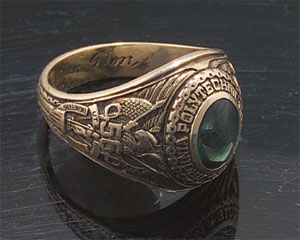 The second ring, which debuted in 1912, sported a flat square stone, which gave way the next year to a gold seal embossed with VPI, the class numeral, and an eagle. Since the first ring had used, in tribute to the school's military tradition, a pair of eagles to symbolize freedom and strength, subsequent rings have always borne at least one eagle, a standard design element that came to be known as "The Screaming Eagle." The second ring, which debuted in 1912, sported a flat square stone, which gave way the next year to a gold seal embossed with VPI, the class numeral, and an eagle. Since the first ring had used, in tribute to the school's military tradition, a pair of eagles to symbolize freedom and strength, subsequent rings have always borne at least one eagle, a standard design element that came to be known as "The Screaming Eagle."
Following the gold seal, an oval stone was introduced in 1914 and used until 1973, when a rectangular-shaped stone was selected. Although the bezel surrounding the stone had always been a rope, the Class of 1940 adopted a chain to symbolize class unity, which ultimately became a standard feature of the ring. Two decades later, the Class of 1961 incorporated oversized block class numerals that have been used since in one form or another.
In the early 1920s, miniature class rings were made available for the cadets to give to their dates. Considered a symbol of commitment, much like the fraternity pin, these miniatures were also frequently used as engagement rings. Because of the gradual increase in female enrollment following World War II, however, the miniatures were eventually replaced by a women's traditional ring.
Respect for the class ring tradition at Virginia Tech has flourished throughout the decades. "During my time as a cadet," remembers Col. Richard "Rock" Roszak (management '71), associate director of the Virginia Tech Corps of Cadets alumni programs, "we coveted the class ring from early in our freshman year when we began to understand what a momentous event it would be in our junior year."
The traditional ring
Likely the most familiar design in each year's class ring collection is Tech's traditional ring. Because it displays a range of meaningful symbols, the traditional ring is arguably the collection's most distinguished--and indisputably its heftiest. In fact, the size of Tech's traditional ring is, in some circles, legendary.
"When I was in school, urban legend had it that if you wore a ring over a certain size, the ring had to be registered as a weapon like a brass knuckle," notes Tech's Associate Vice President for University Relations Larry Hincker (Class of 1972; M.B.A. '94).
A middle-school teacher in Virginia Beach, Va., Anthony Crichton (secondary education '86) says that his male students always comment that his ring is the biggest they've ever seen. "I tell them that if they graduate from Virginia Tech, they can get one. Most of the time, they reply, 'I'm going to Tech.' I'm sure a few of them have, too."
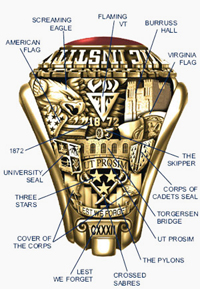 In order to represent both the university and the year's graduating class, each shank of the traditional ring has an established purpose. The "university side" of the ring features the more formal emblems of both Virginia Tech and the nation, such as the university seal, the American flag, crossed sabres, Burruss Hall, and other campus buildings, sites, or traditions selected for inclusion by each class. Past traditional rings have used, for instance, the Pylons, the War Memorial Chapel, Torgersen Bridge, and the corps of cadets' coat of arms. In order to represent both the university and the year's graduating class, each shank of the traditional ring has an established purpose. The "university side" of the ring features the more formal emblems of both Virginia Tech and the nation, such as the university seal, the American flag, crossed sabres, Burruss Hall, and other campus buildings, sites, or traditions selected for inclusion by each class. Past traditional rings have used, for instance, the Pylons, the War Memorial Chapel, Torgersen Bridge, and the corps of cadets' coat of arms.
Conversely, the "class side" of the traditional ring includes not only the class logo, motto, and year, but also emblems individually selected by the class' ring design committee. Over the years, symbols representing life at Virginia Tech that have appeared on Tech rings include the Fighting Gobbler, the HokieBird, Lane Stadium, "Beat U.Va.," a Hokie Passport, and the Cascades, among others.
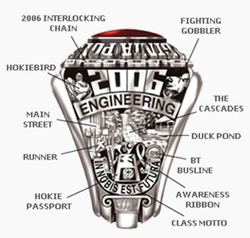 The annual redesign of the ring collection, a tradition that distinguishes Virginia Tech from universities across the country, generates considerable pride among Tech students and alumni alike. In turn, serving on the ring design committee is a special honor that requires both commitment and responsibility. Selected by the class officers in the fall of their sophomore year, the ring design committee--which oversees one of the nation's largest class ring accounts--is comprised of eight members: the design chair, the dance chair, two at-large members, the class president, and three at-large class officers (a male, a female, and a cadet). The committee, which has been advised by the Virginia Tech Alumni Association since 1993, must fashion a ring that not only is unique and meaningful, but also represents Tech's diverse campus life. The annual redesign of the ring collection, a tradition that distinguishes Virginia Tech from universities across the country, generates considerable pride among Tech students and alumni alike. In turn, serving on the ring design committee is a special honor that requires both commitment and responsibility. Selected by the class officers in the fall of their sophomore year, the ring design committee--which oversees one of the nation's largest class ring accounts--is comprised of eight members: the design chair, the dance chair, two at-large members, the class president, and three at-large class officers (a male, a female, and a cadet). The committee, which has been advised by the Virginia Tech Alumni Association since 1993, must fashion a ring that not only is unique and meaningful, but also represents Tech's diverse campus life.
Since 1991, each class has chosen a namesake for its ring collection, a tangible way to pay tribute to Tech's most distinguished alumni and former presidents. Julian A. Burruss (civil engineering 1898), Tech's eighth president, was the inaugural namesake. Subsequent namesakes have included former Tech President Paul E. Torgersen and such eminent Tech graduates as Maj. Gen. W. Thomas Rice (civil engineering '34), Col. Harry D. Temple (industrial engineering '34), and Homer Hickam (industrial engineering '64).
Ringing in a new year
During the fall semester of a class' junior year, the traditional ring, the ring collection, and the collection's namesake are made public at the Ring Premiere, an exciting event that includes giveaways, entertainment, and ring sales immediately after the festivities. Not surprisingly, even outsiders appreciate the event's significance. "The Virginia Tech Ring Premiere," notes Harold Leverett of ring manufacturer Balfour in Austin, Texas, "is the most impressive event I have seen in this industry."
But the real fireworks occur in the spring semester--literally. Often called the highlight of junior year and among the university's most memorable traditions, the Ring Dance weekend features a semi-formal banquet in honor of the ring collection's namesake, a formal dance whose highlight is the ring presentation ceremony, and fireworks over the Drillfield.
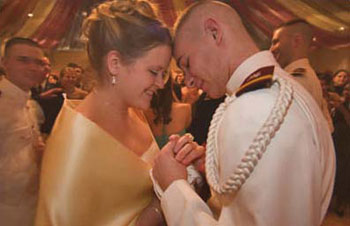 The class ring had been around for more than two decades before the Class of 1935 held the inaugural Ring Dance on April 27, 1934, marking the class' transition from juniors to seniors. At the event, such enduring traditions as the ring figure (class numerals), the sabre arch, and the presentation of the ring by the junior's date were initiated. The class ring had been around for more than two decades before the Class of 1935 held the inaugural Ring Dance on April 27, 1934, marking the class' transition from juniors to seniors. At the event, such enduring traditions as the ring figure (class numerals), the sabre arch, and the presentation of the ring by the junior's date were initiated.
Continuing the traditions established more than 70 years ago, Ring Dance attendees receive ribbons in their class colors (the women wear the darker ribbon and the men the lighter) used to tie each other's rings on their wrists for safe keeping until the ring presentation. The formal presentation of the rings begins with the cadets' formation of the year's ring figure, followed by the formation of the sabre arch, under which a freshman cadet escorts each junior's date.
President Steger (architecture '69; M.Arch '71; Ph.D. environmental science and engineering '78)--who, incidentally, served on the Class of 1969's ring design committee--presides over the formal ring presentation. For most of the students, the presentation is their first view of their actual ring. Roszak recalls, "Each junior cadet picked out a freshman to help him get ready for the big event, from picking up the ring--we couldn't see it until our date presented it to us--to getting the flowers and being our chauffeur."
Since 1942, the ring presentation has been accompanied by the song "Moonlight and VPI," written specifically for that year's Ring Dance by band leader Fred Waring and lyricist Charles Gaynor and first sung by the Fred Waring Glee Club on Waring's CBS Radio network show broadcast from New York City. Amidst the pomp and circumstance, however, a newer tradition, which began as a corps prank years ago, is the release of a small pig into the ballroom after the ring presentation.
Finally, at midnight, fireworks are set off over the Drillfield, and the playing of "Silver Taps" and a report from the Skipper cannon close the evening's events, completing the juniors' symbolic transition to seniors.
With this ring
Though the fanfare passes and the ring cycle begins anew for each rising senior class, a Virginia Tech ring lives on, ever a representation of tradition and pride. "My ring is still one of my most cherished possessions," Roszak says. "It's a common bond all Tech alumni share."
For more about Virginia Tech's class ring tradition, go to www.alumni.vt.edu/classrings/tradition.htm.
Virginia Tech class rings from 1914 to the present are on display in the Williamsburg Room of the Squires Student Center on campus.
Once lost, now found
Name the place you'd least expect to find a Virginia Tech class ring, and chances are, one has been discovered there. Here are just a few of the many stories of lost Tech rings that have been returned to their owners.
Some 20 years ago in Southern Pines, N.C., Richard Frye was repotting a plant when a class ring fell out of the dirt. Although a good washing revealed the name engraved along the ring's band, Frye was told by the university that student information could not be disclosed. After several moves in the ensuing years, Frye rediscovered the ring and, after a Web search, happened upon the Virginia Tech Alumni Association's "Lost and Found Class Rings" page. The ring was returned to Charles Legg Jr. (horticulture '82), who had lost it while working as a landscaper the summer after his graduation.
Rhett M. Lowery (economics '75) lost his 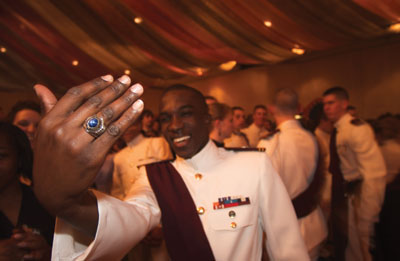 class ring in the parking lot of the Fairfax County, Va., Government Center during a snowstorm more than a decade ago. Though his wife had replaced the ring, Lowery lamented the absence of the corps of cadets crest under the stone. He eventually received an e-mail message from the Bowers family, who had found the ring many years earlier and had nearly given up locating its owner. Mrs. Bowers shared that when she had considered selling the ring on eBay, her husband had discouraged her, so she performed a Web search, "lost and found college rings." "Virginia Tech was the only college that came up with its own listing!" she said. class ring in the parking lot of the Fairfax County, Va., Government Center during a snowstorm more than a decade ago. Though his wife had replaced the ring, Lowery lamented the absence of the corps of cadets crest under the stone. He eventually received an e-mail message from the Bowers family, who had found the ring many years earlier and had nearly given up locating its owner. Mrs. Bowers shared that when she had considered selling the ring on eBay, her husband had discouraged her, so she performed a Web search, "lost and found college rings." "Virginia Tech was the only college that came up with its own listing!" she said.
On a Cape Cod beach in July 1973, Larry Williams (statistics '70) was skipping stones in the surf when he felt his ring slip off. "I was crushed," Williams recalls, "because, as all of us know who've graduated from this university, that ring is a symbol of the sweat invested in earning the degree, as well as a visible, lasting reminder of our experiences at Tech." Last September, the Alumni Association informed Williams that his ring was being held by a Canadian, Les Hegyi, who, it turns out, had found the ring when he was three years old. "Les told me that he had seen something sparkly in the surf as he walked with his parents and had picked it up." Hegyi rediscovered the ring a few years ago in a shoebox filled with some childhood things that his parents had kept. He noted Williams' name and hometown inside the ring but was unable to find anyone at the university who could help him locate the ring's owner. This past summer, he decided to contact Tech again, this time via the Alumni Association’s webpage. "I'm proof that neither international boundaries nor the span of more than 30 years is enough to keep a Tech ring from finding its way back to its owner," says Williams.
Most Virginia Tech class rings can still be ordered from their original manufacturers; however, new orders, repairs, or replacements require authorization from the Virginia Tech Alumni Association.
Alumni from 2005 and earlier should contact Shirley Fleet at fleets@vt.edu for ring requests.
Current student ring requests (2006 and 2007) should be directed to Laura Wedin at lwedin@vt.edu.
For more information on ring authorizations and ordering, visit the Alumni Association's class ring site at www.alumni.vt.edu/classrings.
|